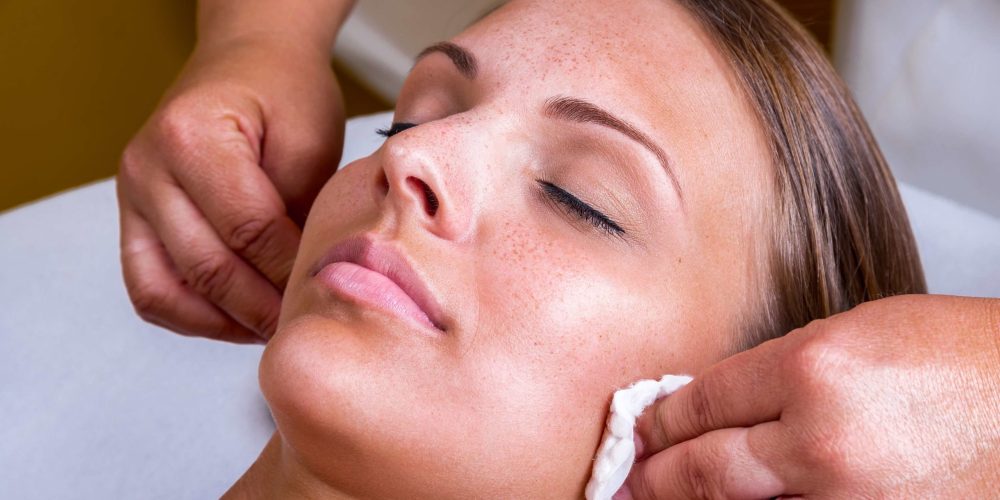A chemical peel is a procedure that removes the outermost layers of skin using a chemical solution in order to expose the younger, healthier skin that lies in the wait. Chemical peels can be used to minimize the appearance of scars, an inconsistent skin tone, fine wrinkles, acne, as well as other skin flaws. They can also improve the overall appearance of the skin. The precise nature of the skin condition that needs to be treated and the depth of the Peel will be determined by the specific combination of these chemicals.
The use of a chemical solution is required in order to perform a chemical peel, which is also known as chemexfoliation or derma peeling. This procedure is performed in order to improve the appearance of the patient’s skin.
During this procedure, a chemical solution is administered to your skin, ultimately damaging the skin’s various layers. The end effect of this treatment is that your skin will look and feel different. With the passage of time, the layers of skin start to shed, revealing skin that looks younger than it actually is. In most cases, the newly regenerated skin has a more consistent tone, a less harsh texture, and fewer wrinkles and creases than the older skin did.
What kinds of issues with the skin can be improved with the help of a chemical peel?
Chemical peels can be applied in the treatment of a range of skin problems. Additionally, chemical peels have been utilized in the process of boosting the appearance of a person by improving the complexion of their skin.
Your dermatologist will determine the depth of the Peel that is best suited for you to have done. This decision might change based on the outcomes sought for the therapy and the state that your skin is currently in.
Chemical peels could perform better when addressing sags, puffiness, deep facial lines, or creases that are more severe. If these were the key concerns you intended to address via cosmetic surgery, then you must consider other operations, such as a facelift or soft tissue filler. You will be able to select the course of therapy that will be the most successful for your circumstances if you work with the help of a dermatologic surgeon.
Peels that are only superficially applied are generally safe and effective treatments for all varieties of skin. However, if you already have darker skin than the average person, you have a greater risk of suffering discoloration of your skin as a negative effect of the treatment. This is because darker skin absorbs more of the medication. The term “post-inflammatory hyperpigmentation” is used by those who work in the medical field to describe this syndrome.
If you have naturally darker skin, consulting a dermatologist about different less invasive procedures can be something you want to consider doing. This is especially the case if you wish to lighten scars or other skin imperfections. By taking these steps, you will lower the likelihood that you may experience hyperpigmentation in the future.
What are the stages that comprise the process of applying a chemical peel to the patient?
A chemical peel is a procedure that can be carried out in an outpatient setting at a surgical facility or a doctor’s clinic. This type of procedure is intended to improve the appearance of the patient’s skin. Your eyes and hair will be shielded, and a cleanser that is effective at removing excess oil will be used to give your skin a deep clean. All of this will take place while your eyes and hair are guarded. The application of a chemical solution to your skin is the next step in the process.
Each sort of chemical can penetrate the skin to a specified depth, at which point it causes a controlled quantity of damage and then allows the top layer of skin to flake off and expose a new layer of skin behind it.
Elimination of Acne by the Use of Chemical Peels
Acne is a skin disorder that affects millions of people and is very common. In spite of how frequent it is, how it affects your appearance can lead to problems with self-confidence. This is because of the way that it makes you look. Medications used topically or taken orally are typically effective in treating acne. Nevertheless, there are several cosmetic procedures that are also capable of addressing acne problems. You might be curious about whether or not chemical peels are helpful for acne.
There is a wide variety of variety when it comes to the sorts of chemical peels. One of the most prevalent cosmetic procedures is a chemical peel that is only superficial. Because they are so quick and require a little recovery period, people frequently call these peels “lunch hour” peels. The outermost layer of your skin will be stripped away when you get a chemical peel done. This makes way for the growth of fresh, healthy skin underneath. They are a great form of cosmetic treatment due to the fact that they are non-invasive and may help you maintain and revitalize the appearance of your skin regardless of how old you are.
Chemical peels are an effective method of treating acne that may be used by anyone of any age, including teenagers and adults who are still struggling with acne outbreaks. This is because chemical peels work by exfoliating the skin.
The major benefits of glycolic acid, which is a common ingredient in acne chemical peels, include:
- The elimination of excess oils.
- A reduction in the severity of pore blockage.
- A lessening in the frequency of acne outbreaks.
Glycolic acid may be found in many acne chemical peels. Many acne chemical peels contain glycolic acid as an active ingredient.
In order to address the concerns that you have expressed regarding the condition of your skin, Isla Aesthetics provides the chemical Peel in a number of different concentrations. Chemical peels are able to refine and smooth the epidermis and reduce acne, in addition to accelerating the normal turnover of skin cells, which is one of their primary benefits.




